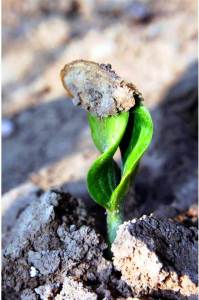Soil is essential to life. That’s why we hear more every day about the microbes that inhabit soil1. What many don’t realize, however, is that those microbes are related to the emerging field of “soil health.” Microbes also affect how soils are tested in laboratories. This topic has captured the attention of farmers, scientists and politicians…even becoming a focus for 2015’s “International Year of Soils.”

Due to the surging interest in soil health, a new group of government and private sector agriculturalists is holding discussions. The outcomes may change how soil tests are done and how results are reported. Farmers have soil tests done so they can calculate if they need to apply fertilizers, or change the pH of their soil. Many home gardeners have their soil tested as well. In the near future the nitrogen, phosphorus and potassium recommendations on your soil report may have just as much to do with microbes as it has to do with available nutrients.
How do soil microbes affect the nutrients available in the soil for plants? Soil microbes are part of a very complex food web that occurs in soil, but we’ll focus on just a few main topics.
Many growers and gardeners leave some or all of their crop residue on the soil. This is good for many reasons, outlined in this blog post. Basically, the dead plant material is “recycled” back into the soil. This adds nutrients – nitrogen, phosphorus, potassium and more – that you won’t have to add as fertilizer (or at least reduces the amount of fertilizer needed.)

If crop residues did not decompose and disappear, they would build up and become a problem. The nutrients contained in them would not be released back to the soil. That would require more fertilizer to compensate. The time it takes for these nutrients to be recycled can vary from weeks to months. In a recent Canadian study, straw residue on various farms showed strikingly different rates of decomposition. Earthworms were cited as a major factor for reducing the time it took for litter to disappear. The earthworms eat and digest the plant residue, moving nutrients back into the soil more quickly. There are new tests that show the activity of microbes in soil; it is often directly related to earthworm counts.
Another form of recycling nutrients has to do with the geologic “parent material” of soil – the original rocks and stones. A study in Scotland2 recently showed that potassium in rocks is “unlocked” by the slow action of carbonic acid. Interestingly, microbes produce this acid during decomposition of crop residues! Some researchers have called for reassessment of potassium fertilization since the pool of potassium from “fixed” sources – like rocks – was not considered available to plants.
Growers are not used to accounting for this form of potassium when calculating their nutrient needs. There is evidence that adding potassium fertilizers slows down the natural release of these minerals. Soils in the top layer have substantial potassium resources within rock minerals; it seems we are overlooking some of the soil’s ability to provide its own nutrients. Of course, the amount of microbes in the soil may affect how much the potassium is available.
All major (and many minor) plant nutrients are biologically relevant and are important in soil testing. The most manageable is nitrogen, because such large quantities are cycling in plant litter, organic matter and manure. A substantial reserve of nitrogen accumulates in soil humus that is released again each year. Phosphorus is found in all organic matter and accumulates in partially fixed form due to fertilization. It is also slowly re-released and made available by biological forces. Finally, a large and underappreciated reserve of potassium exists in most soils in the form of rocks and stones. This reserve has been viewed as insignificant for soil nutrient management strategies. New information tells us this natural potassium reserve plays into nature’s larger cycling and impacts sustainability.
Your future soil test might not just tell you about the nutrients currently in your soil. It might indicate the amount of nutrients that came from your fertilizer versus the amount that came from crop residues and soil parent material due to microbial activity. It’s all about increasing nutrient efficiency with better accounting practices in our soil testing.
Answered by – Will Brinton, University of Maine, and Director, Woods End Soils Lab
To receive notices about future blogs, be sure to subscribe to Soils Matter by clicking on the Follow button on the upper right! Explore more on our webpage About Soils. There you will find more information about Soil Basics, Community Gardens, Green Infrastructure, Green Roofs, Soil Contaminants, materials for Teachers and more.
If you’d like to watch a video about a researcher who uses microbes to clean water watch here.

If only every gardener really appreciated how important the soil is before they spend their money buying plants. 🙂
We agree! Thanks for reading!
That’s true I agree with this as myself had mango plant grown in a pot without any of the fertilizers only with the snails and the left over of tea
Thanks for the post. Yes, microorganisms play a vital role in soil health and plant growth.
Thank you!